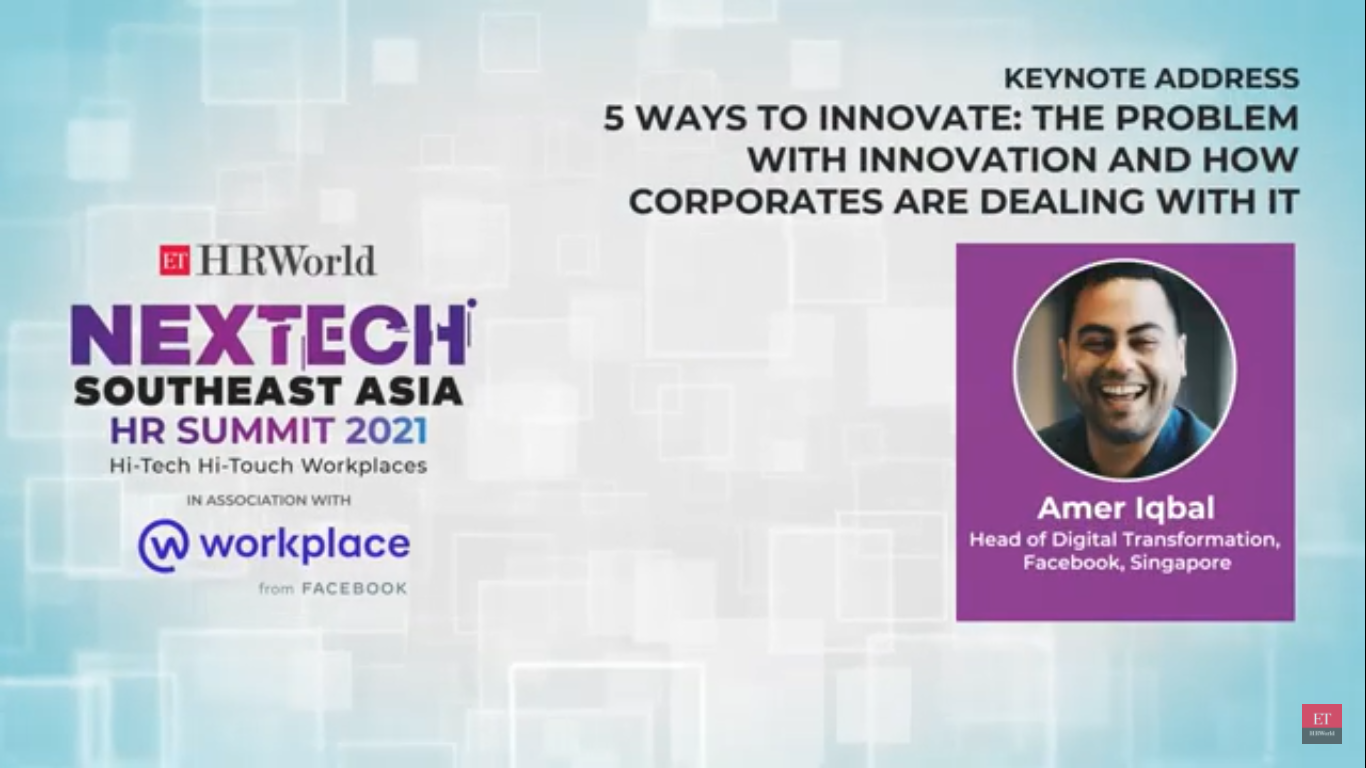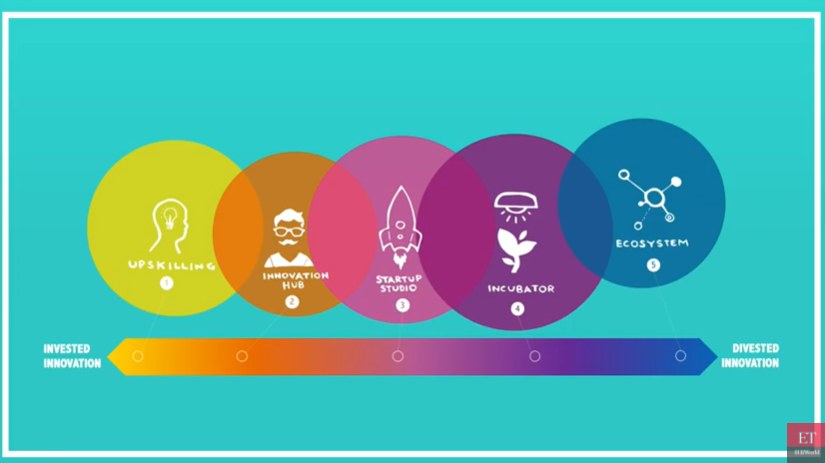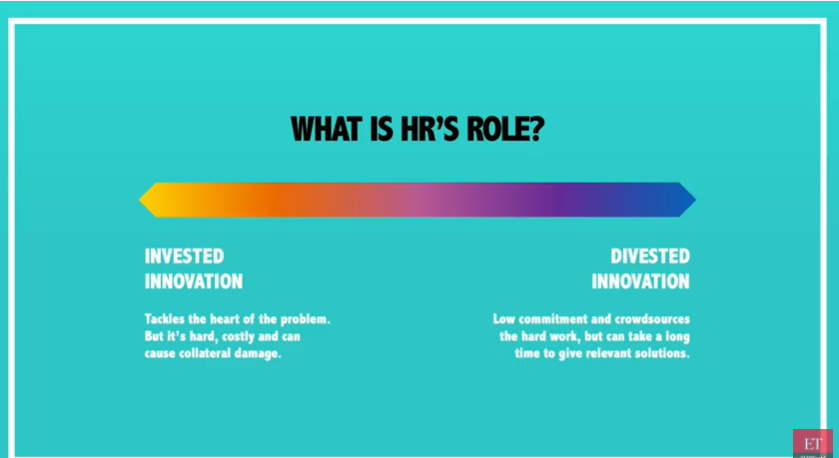5 Ways to Innovate: Amer Iqbal Keynote @ Nextech HR Summit 2021
Amer Iqbal presented the keynote presentation at the 2021 NexTech HR summit.
The focusing question of the session was: "Can HR enable corporate innovation?" Watch the video above to see the keynote on 5 Ways to Innovate.
The following article by Pratha Arora was published by Economic Times on October 15 2021 as a summary of the key points from Amer's keynote. You can see the original article here.
The most successful innovators treat innovation as a portfolio: Amer Iqbal at NexTech Southeast Asia HR Summit 2021
To delve deeper into a super insightful innovation cycle, the associated challenges, and the way forward, ETHRWorld International for its largest virtual HR conference of the year- The NexTech Southeast Asia HR Summit 2021 invited Amer Iqbal, Innovation Consultant, and Author of the upcoming book ‘The 5 ways to Innovate' to deliver an outstanding keynote presentation on the topic: 5 ways to innovate, the problems with innovation and how corporates are dealing with it. Presenting a few excerpts from the session!
Pratha Arora, ETHRWorld Updated: October 15, 2021, 08:17 IST

5 ways to innovate: Amer Iqbal, Head of Digital Transformation at Facebook
A period of constant fear, frequent failure, and extensive experimentation has changed our outlook on work and life in unprecedented ways. The unstated needs and demands of the future have propelled businesses to bring intense focus, speed, and agility in their systems and innovation at the core of every process. But while corporations spend billions of dollars on their business recovery model, only a few understand the power of strategised innovation. We need to understand that innovation is not a defined goal but rather a process that needs to be continuously evaluated, refined, and redesigned. And therefore, before fixating any innovation agenda, business leaders and HR practitioners need to look at several associated challenges and the most efficient ways to innovate an approach that will not only accelerate their business growth today but will help them build a foundation for tomorrow.
To delve deeper into one super insightful innovation cycle, the associated challenges, and the way forward, ETHRWorld International for its largest virtual HR conference of the year- The NexTech Southeast Asia HR Summit 2021 invitedAmer Iqbal, Innovation Consultant and Author of the upcoming book ‘The 5 ways to Innovate’ to deliver an outstanding keynote presentation on the topic: 5 ways to innovate, the problems with innovation and how corporates are dealing with it.
Talking points from the keynote session:
Problems with innovation: The most common challenges facing corporations when undertaking an innovation agenda
The five ways to innovate
HR led innovation: Role of HR practitioners in driving, shaping, and building the future of business
Case Study presentation of Union Bank, The Philippines
Presenting a few excerpts from the session:
Three big problems with innovation
Amer started the session by talking about one of the most eventful days in human history, the launch of the world's first sustained flight by the Wright brothers on December 17th, 1903. The leader highlighted how this life-changing invention came to nobody's immediate attention until a few mainstream reporters broke the news after four long years.
Exemplifying this along with several other historical cases such as the Western Union’s response to the telephone invention or the memo issued by the US Congress when automobiles were first invented, the leader pointed out the first challenge with innovation- it is hard to see and sometimes, even experts fail to acknowledge the change. "There is a gap between a game-changer and the people recognising that the game has been changed", he added.
The second big problem with innovation is, it happens gradually over time. Sharing Andy Jassy's concept behind starting Amazon Web Services, Amer highlighted how it took years until cloud computing was taken seriously and today, there is no IT department on the planet that doesn’t have some sort of cloud infrastructure or cloud strategy. He further pointed out the difference between invention and innovation, stating that innovation clearly isn’t a light bulb moment and it happens gradually, taking years for the process to come into fruition sometimes.
And finally, he discussed the biggest problem with innovation- it requires us to change.
“Without actually changing ourselves we have no hope of changing the organisation and therefore it doesn't serve the innovation agenda so three key problems with innovation is that it’s hard to see, it happens gradually, and it requires us to change. Form huge stumbling blocks and explain why there is so much churn around the innovation industry and we hear so much talk about innovation theater. They are hard hurdles to overcome but not insurmountable", he added.
The five key strategic ways to innovate
Speaking about the most strategic ways to innovate, the leader shared while it is true that there can be hundreds of different innovation approaches under hundreds of different names, but by looking at the overlaps and find the commonalities, we can explain about 80-90 percent of the corporate innovation approaches using five key categorisations/buckets of innovation.

Five ways to innovate
1. Upskilling Initiatives
Deliberating on the need to make companies and people more innovative, Amer shared that upskilling directly tries to tackle the problem at the heart and this can be established with initiatives like agile training programs in universities, rolling out large scale certification, and strengthening the capabilities of our own workforce and people and these can be great because they tackle the heart of the problem. Speaking of its limitation, he said that rather than leading from the front of the industry, what they tend to end up doing is bringing up the rear.
2. Innovation Hubs
In order to make the companies more innovative, the leader suggested that we can start attracting technologists and entrepreneurs and design thinkers, the type of talent that can work on the business ideas of tomorrow. This can be accomplished with a non-conventional, funky organisational culture and team setup; more of a "digital garage" style environment.
3. Startup studio
The Startup Studio focuses on building a venture or multiple ventures today that could potentially become the business of tomorrow. For this, the leader suggested that we must seek some external help from consultants due to a lack of internal capabilities. So the goal is to build a startup environment, operating within the umbrella of an organisation with a team of consultants and then handover to the clients to build capability over time.
4. Incubators
Another way to innovate, the speaker added, is by adding incubators that are essentially early stage or later stage external startups that can be bought with some funding and allowing those startups to thrive in their own environment. The benefit here is the freedom for startups to operate freely, embracing and de-risking "failure" from a corporate standpoint. However, the challenge arises when the relevance of startups to parents is not guaranteed, and when corporations are asked to make a long-term investment decision.
5. Ecosystem
Building an ecosystem requires scanning through a broad startup ecosystem to make investment decisions around acquisitions or partnerships as needed. The fact that an ecosystem needs minimal investment in ongoing sensing makes it beneficial for corporations.
After enlisting the benefits and drawbacks of the five key strategic ways to innovate in great detail, Amer commented, "When we lay out these five ways to innovate across the spectrum, what we see is a pattern. From the left side, we see an upskilling and innovation approach, which is a very invested innovation approach wherein we take on the innovation agenda internally with our people and build the capabilities from within. At the other end of the spectrum, we see a divested innovation approach wherein we sit back and passively let the market do the work and dip in opportunistically when the time is right."
"The most successful innovators treat innovation as a portfolio"
Sharing his insights on the best way to innovate, he said, "If you look at the most innovative companies on this planet, they are not just investing in one of these five. If you look at Alphabet, Amazon, or Apple, these companies are investing across all five ways to innovate and in fact, they take multiple initiatives across each of these five. If a company is hoping to succeed in their innovation agenda, it really needs to look at a portfolio."
When it comes to building a successful innovation operation, a company has to place multiple bets across the entire portfolio, he added.
Role of HR practitioners in driving, shaping, and building the future of business
“What is the role of HR leadership and HR practitioners in shaping, driving, and having a seat at the table when it comes to building tomorrow's business?”
Sharing a very interesting HR leadership approach with the audience, Amer stated "What we need to do as HR leaders is think about not just changing how we do work but changing the work that we do in service of building the business of tomorrow and that's ultimately what any innovation initiative should be laddering up to."

Invested & Divested Innovation
According to the leader, another key strategic decision for HR leaders is to choose between an invested or a divested innovation approach. Explaining both sides of innovation, he added that the invested side of the innovation approach will drive more responsibility towards HR leaders in terms of shaping future businesses. However, they may have to rely on an ecosystem or a divested approach in case they lack the internal capabilities to accomplish the set goals. While an invested approach tackles the heart of the problem, it is definitely hard and costly whereas a divested innovation approach requires low commitment and crowdsources the hard work but renders relevant solutions in a long time.
Case Study: Union Bank, The Philippines
Amer ended this session with an excellent case study of good HR-led innovation by Union Bank, Philippines. Having previously worked with the bank as a consultant, he shared that Union Bank is no stranger to innovation, In fact, it was the first in the Philippines to start internet banking with open API platforms. By 2018, they had grown to become the seventh-largest bank in the region but it definitely took some real recognition in climbing up the ladder, added Amer. Instead of simply replicating their competitors' initiatives, they envisioned a very lofty innovation agenda by setting up a data technology business of tomorrow with added banking utilities. What they had to figure out next was how to bring their aspirations to life. Realising that technology is a major part of it, it was also well established that it also acts as an equaliser, which made people the true differentiators.
While the CHRO acted as the key sponsor in driving the program with a lot of employee-centric initiatives across the organisation such as building an innovation hub, running hackathons, and rolling out agile training, they still needed to be consolidated with other efforts to drive the innovation agenda. So they also rolled out network-based teams across the organisation along with HR that was key to unlocking some of the benefits of agile training. With such collaborative efforts, he shared how within a very short span of time, they were able to prepare squads to self-manage and operate in an agile work landscape and make business decisions without uncovering every layer of the process.
Next on their agenda was building more muscle for the future of business and within the next six months, they did not only manage to set up the speedboat factory but had already launched the first five speed boats, which went on to become the most innovative digital banking product of the year in the Philippines.
"It was a great example of how HR is not just having a seat at the table but also taking charge and leading the innovation agenda to build the data technology business of tomorrow", he concluded.
Follow and connect with ET on Twitter, Facebook, Linkedin, Youtube
